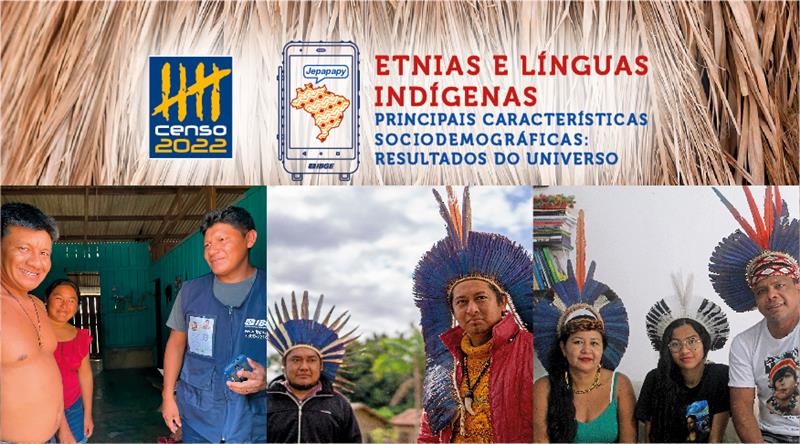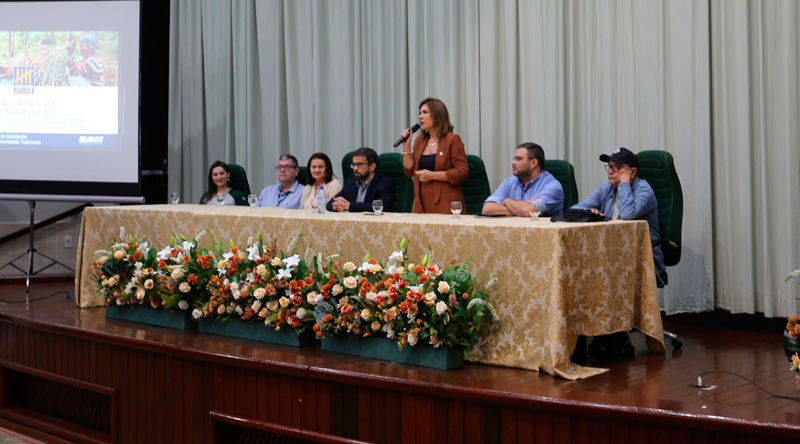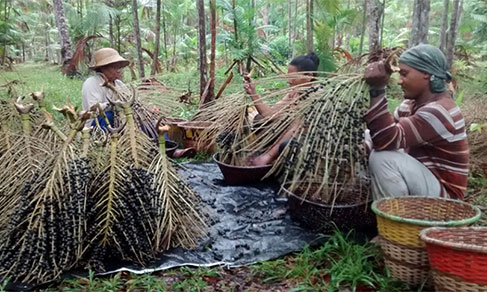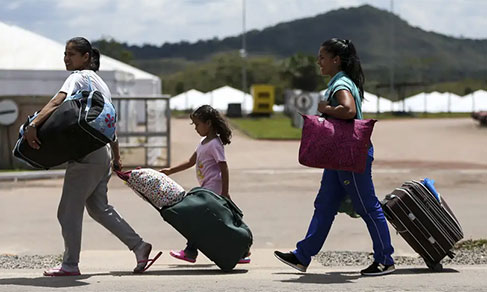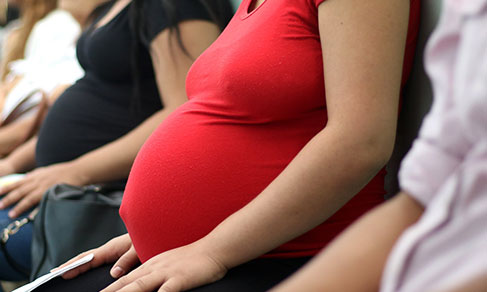Nossos serviços estão apresentando instabilidade no momento. Algumas informações podem não estar disponíveis.
Population Census
About - Commuting to work and to school | Preliminary sample results
With this publication, the IBGE (Brazilian Institute of Geography and Statistics) proceeds with the dissemination of data collected in the 2022 Population Census Sample Questionnaire, providing information on the population's commute to work and school. Due to their impact on population's quality of life and productivity, as well as on the labor market, such commutes are a traditional topic in census operations, as demonstrated by the history of the surveys conducted since 1970.
In this edition of the survey, the overview of commutes to and from work covers the following topics: location of the person's sole or main job during the reference week; frequency of return from work to home (three or more days per week); commute time between home and work; and the main mode of transportation used for this journey, considering, in the case of more than one mode of transportation, the one with the longest commute time. The analysis of commutes to study, in turn, takes into account the municipality or foreign country in which the education institution (from daycare to doctoral studies) is located.
Over the years, the mobility characteristics of the Brazilian population have changed profoundly. The implementation of new modes of transportation for commuting, the modernization and expansion of the road network throughout Brazil, accelerated urban growth, and, in addition, the increased availability of educational institutions and employment options, among other factors, have brought significant changes to connections between locations in Brazil. As a result, mobility-related issues have gained greater relevance and become a major focus of public policies at the federal, state, and municipal levels, as well as a focus of attention for private companies nationwide. It is important to emphasize that the systematic production of statistics on this topic facilitates the planning and management of transportation systems, based on informed flow intensity, and provides opportunities for improving the population's quality of life, not only by reducing travel costs and time, but also by impacting pollution levels and people's health, among other aspects. The Population Census, due to its territorial scope and capillarity, will play a key role in the production of these statistics, thus contributing to the continuous functional integration between Brazilian localities, as well as to the temporal monitoring of the evolution of mobility in the country.
The results presented here cover Brazil, Major Regions, Federation Units, Urban Concentrations, Intermediate Geographic Regions, Immediate Geographic Regions, and Municipalities, and are disaggregated by sex, race, income, and schooling level of individuals aged 10 years and over. These results are considered preliminary because they are based on the Preliminary Census Meshes of Enumeration Areas, released in March 2024, and will be enriched in the future with the provision of indicators by Weighting Areas (Aponds).
The technical notes included in this publication discuss the main methodological aspects of the census, comment on the preliminary nature of this publication, and describe the terms and concepts considered relevant to understanding the results.
This set of information can be accessed on a variety of ways on the IBGE website, including the IBGE Automatic Retrieval System (Sidra), the 2022 Census Overview channel, and the survey page, which brings together multiple aspects of the operation's conduction.
Main results - Commuting to work and to school | Preliminary sample results
Acesse os principais resultados no Panorama do Censo 2022.
The IBGE adopts a review policy of the data disclosed by this statistical operation. Data review means any and all scheduled revision of numerical data due to new information, which was not accessible at the time of the first disclosure. For instance: late data that replaces a non-response; or data corrected by the informant himself; or a set of data that has undergone editing and imputation. For more detailed information about the published data review policy of the IBGE statistical operations, check the list of short-term, long-term and special surveys carried out by the Institute with their respective revision procedure on: https://biblioteca.ibge.gov.br/index.php/biblioteca-catalogo?view=detalhes&id=298009.
Tables - Commuting to work and to school | Preliminary sample results
Access to the SIDRA System
You can access the complete tables available in the SIDRA system in Commuting to work and to school: Preliminary Sample Results
The IBGE adopts a review policy of the data disclosed by this statistical operation. Data review means any and all scheduled revision of numerical data due to new information, which was not accessible at the time of the first disclosure. For instance: late data that replaces a non-response; or data corrected by the informant himself; or a set of data that has undergone editing and imputation. For more detailed information about the published data review policy of the IBGE statistical operations, check the list of short-term, long-term and special surveys carried out by the Institute with their respective revision procedure on: https://biblioteca.ibge.gov.br/index.php/biblioteca-catalogo?view=detalhes&id=298009.
Concepts and methods - Commuting to work and to school | Preliminary sample results
As informações a seguir descrevem os metadados estatísticos, que são o conjunto de conceitos, métodos e aspectos relacionados às estatísticas, e são informações necessárias para compreender as características e a qualidade das estatísticas e interpretá-las corretamente.
Informações Gerais
Objetivo
O Censo Demográfico tem por objetivo contar os habitantes do território nacional, identificar suas características e revelar como vivem os brasileiros, produzindo informações imprescindíveis para a definição de políticas públicas e a tomada de decisões de investimentos da iniciativa privada ou de qualquer nível de governo. Também constitui a única fonte de referência sobre a situação de vida da população nos municípios e em seus recortes internos, como distritos, bairros e localidades, rurais ou urbanas, cujas realidades dependem de seus resultados para serem conhecidas e terem seus dados atualizados.Tipo de operação estatística
Censo demográficoTipo de dados
Dados de pesquisa por amostragem probabilística, Dados de Censo, Dados agregadosPeriodicidade de divulgação
DecenalPopulação-alvo
O censo brasileiro adota o conceito de população residente ou "de direito", ou seja, a população é enumerada no seu local de residência habitual. Outros países fazem o levantamento da população "de fato", ou seja, no local em que se encontrava na data de referência do censo. Dadas as características continentais do Brasil e a forma de utilização da informação censitária, a escolha vem recaindo em todos os últimos censos sobre o uso da primeira alternativa.Metodologia
Além desta modalidade tradicional, para o Censo Demográfico 2022 abriu-se a possibilidade de coleta por meio da Internet. O Recenseador poderia oferecer essa alternativa a pedido do morador; ou quando houvesse restrições de acesso a áreas específicas, por exemplo, no caso de condomínios fechados; ou quando fosse encontrada qualquer outra dificuldade para fazer a coleta na modalidade entrevista presencial. Houve também um aumento de coleta nos Povos e Comunidades Tradicionais, onde pesquisou-se, pela primeira vez, as comunidades quilombolas.
Técnica de coleta:
CASI - Questionário eletrônico autopreenchido, CAPI - Entrevista pessoal assistida por computadorProcedimento de amostragem
A partir do Censo de 1960 foi adotado um modelo de técnica de amostragem probabilística que vem se mantendo para os demais censos, onde utilizou-se dois modelos de questionários: amostra e básico (não amostra).O esquema de amostragem utilizado nos Censos Demográficos brasileiros é uma amostra estratificada, considerando como estrato o setor censitário. A seleção de domicílios é feita de forma sistemática, independentemente em cada setor e com equiprobabilidade.
Nos Censos de 1960, 1970 e 1980 o questionário da amostra foi aplicado em 25% dos domicílios particulares e pessoas nele residentes e 25% das famílias ou pessoas sós residentes em domicílios coletivos.
Para os Censos de 1991 e 2000, após estudos realizados por especialistas em amostragem, foram adotadas frações amostrais diferenciadas, de acordo com o tamanho da população do município. Assim, os municípios com até 15.000 habitantes tiveram 20% de seus domicílios investigados pelo questionário da amostra e nos municípios com mais de 15.000 habitantes, a fração amostral foi de 10%.
Já para a amostra do Censo 2010 teve cinco frações diferentes usadas de acordo com o total da população do município. Nos municípios com até 2.500 habitantes, a fração amostral foi de 50%, ou seja, em metade do total de domicílios foi aplicado o questionário da amostra. Os que tinham mais de 2.500 até 8.000 habitantes, tiveram a fração amostral de 33%. Nos municípios com mais de 8.000 até 20.000 habitantes, a fração foi de 20%. Já nos que tinham mais de 20.000 até 500 mil habitantes, a fração foi de 10%. E, por fim, nos municípios com população maior que 500 mil, a fração foi de 5%. A definição de mais de duas frações amostrais só se deu em função da facilidade operacional, de aplicação e de controle, permitida com o uso dos computadores de mão na operação de coleta de dados.
Para o Censo Demográfico 2022, seguiu-se a mesma lógica do Censo Demográfico 2010. A seleção dos domicílios para a amostra, o que significava definir qual tipo de questionário seria aplicado em um determinado domicílio, foi feita automaticamente no dispositivo móvel de coleta (DMC). Os domicílios, cadastrados no DMC, fizeram parte de uma lista da qual a amostra foi selecionada. A seleção é aleatória, independente em cada setor censitário, de acordo com a fração amostral definida para o município, e de forma que seja espalhada geograficamente por toda a extensão do setor censitário.
Crítica e imputação
Todos os dados coletados passaram, no momento da entrevista, pelo processo de crítica eletrônica, cuja finalidade era eliminar inconsistências entre as informações dos diversos quesitos do questionário provenientes de equívocos ou não respostas durante a fase da coleta.Foram introduzidas também algumas críticas de incompatibilidades que subsidiassem de forma consistente os recenseadores em relação as variáveis sexo, idade, relação de parentesco etc, e, também, o uso de funções e mensagens de advertência, facilitando o preenchimento do questionário de acordo com os saltos existentes, bem como inibindo determinadas categorias de respostas que, de acordo com a idade declarada, não deveriam ser assinaladas.
A depuração dos dois conjuntos de dados, universo e amostra, contou com a utilização de dois softwares: CANCEIS – CANadian Census Edit & Imputation System, desenvolvido pelo Statistics Canada e seguidores da metodologia de Fellegi & Holt e SAS – Statistical Analysis Sistem.
Para as informações referentes às características de pessoa e domicílio, utilizou-se o sistema de crítica e imputação CANCEIS (Canadian Census Edit and Imputation System), no qual o processo de imputação foi realizado por meio de registros doadores, selecionados aleatoriamente entre os registros sem erros. Para alguns casos, foi utilizado um Sistema web, no qual os registros com erro foram corrigidos manualmente a partir de regras preestabelecidas, com intervenção de operadores especialmente treinados.
A imputação pressupõe uma organização dos registros em estratos, cuja variável de estratificação e o número de moradores dos domicílios. Um domicílio é considerado um potencial doador se, para uma determinada aplicação, por exemplo, estrutura do domicílio, para a qual ele foi efetivamente utilizado, ele não possua erros, ou seja, uma vez submetido as regras de crítica, nenhuma falha foi detectada. Quando esse passo não corrigiu o erro através dos softwares apresentados, foi utilizado um sistema Web para imputação manual.
Essa foi uma das razões para que o tamanho dos lotes fosse diferente em algumas de suas etapas, pois, quando os registros são separados em estratos, faz-se necessário trabalhar com lotes maiores, de modo que nos estratos mais rarefeitos (aqueles formados por domicílios com maior número de moradores) seja possível obter doadores para domicílios com erro.
Temas
Temas e subtemas
Família, Grupos populacionais específicos, Trabalho, Trabalho remunerado, Outras formas de trabalho, Rendimento, despesa e consumo, Estatísticas multidomínio, Gênero, População, Condições de vida, pobreza e desigualdade, Educação, Nupcialidade, Características gerais da população, Habitação, Cultura, recreação e esporte, Sociedade da Informação, Saúde, Componentes da dinâmica demográfica e estatísticas vitais, Proteção socialPrincipais variáveis
Variáveis Geográficas• Unidade da Federação
• Município
• Região Geográfica
• Concentração Urbana
• Situação do domicílio
Variáveis do Registro de Domicílios
• Espécie
• Tipo de espécie
• Domicílio, condição de ocupação
• Valor do aluguel (em reais)
• Aluguel em número de salários mínimos
• Material predominante, paredes externas
• Cômodos, número
• Cômodos como dormitório, número
• Banheiro de uso exclusivo, número
• Sanitário ou buraco para dejeções, existência
• Esgotamento sanitário, tipo
• Abastecimento de água,
• Abastecimento de água, canalização
• Lixo, destino
• Máquina de lavar roupa, existência
• Acesso à internet, existência
• Morador, número
• Densidade morador/cômodo
• Densidade morador/dormitório
• Quantas pessoas moravam neste domicílio em 31 de julho de 2022
• De agosto de 2019 a julho de 2022, faleceu alguma pessoa que morava com você(s) (Inclusive crianças recém-nascidas e idosos
• Rendimento do responsável, salários mínimos, em julho de 2022
• Rendimento mensal domiciliar em julho de 2022
• Rendimento domiciliar, salários mínimos, em julho de 2022
• Rendimento domiciliar per capita, em julho de 2022 (em reais).
• Peso
• Área de ponderação
Variáveis do registro de Mortalidade
• Unidade da Federação
• Município
• Região Geográfica
• Mesorregião
• Microrregião
• Concentração Urbana
• Situação do domicílio
• Mês e ano de falecimento
• Sexo da pessoa falecida
• Idade ao falecer, em anos
• Idade ao falecer, em meses
• Peso
• Área de ponderação
Variáveis do Registro de Pessoas
• Unidade da Federação
• Município
• Região Geográfica
• Mesorregião
• Microrregião
• Concentração Urbana
• Situação do domicílio
• Relação de parentesco ou de convivência com a pessoa responsável pelo domicílio
• Sexo
• Variável auxiliar da idade calculada (anos e meses).
• Idade calculada em anos:
• Idade calculada em meses - menores de 1 ano
• Indicadora da forma de declaração da idade
• Cor ou raça
• Registro de nascimento
• Dificuldade permanente de enxergar
• Dificuldade permanente de ouvir
• Dificuldade permanente de caminhar ou subir degraus
• Deficiência mental/intelectual permanente
• Nasceu neste município
• Nasceu nesta Unidade da Federação
• Nacionalidade
• Ano que fixou residência no Brasil
• Unidade da Federação ou país estrangeiro de nascimento
• Unidade da Federação de nascimento
• País estrangeiro de nascimento
• Tempo de moradia na UF
• Tempo de moradia no município
• Unidade da Federação e município ou País estrangeiro de moradia antes de mudar-se para este município
• UF de residência anterior
• Município de residência anterior
• País estrangeiro de residência anterior
• Residência em 31 de julho de 2017
• UF de residência em 31 de julho de 2017
• Município de residência em 31 de julho de 2017
• País estrangeiro de residência em 31 de julho de 2017
• Sabe ler e escrever
• Frequenta escola ou creche
• Curso que frequenta
• Série/ano que frequenta
• Série que frequenta
• Conclusão de outro curso superior de graduação
• Curso mais elevado que frequentou
• Conclusão deste curso
• Espécie do curso mais elevado concluído
• Curso Superior de Graduação
• Curso de Mestrado
• Curso de Doutorado
• Nível de instrução
• Município e Unidade da Federação ou país estrangeiro que frequentava escola ou creche
• Unidade da Federação que frequentava escola ou creche
• Município que frequentava escola ou creche
• País estrangeiro que frequentava escola ou creche
• Vive em companhia de cônjuge ou companheiro(a)
• Número de ordem do cônjuge ou companheiro(a)
• Natureza da união
• Estado civil
• Trabalhou ganhando em dinheiro, produtos, mercadorias ou benefícios
• Tinha trabalho remunerado do qual estava temporariamente afastado(a)
• Ajudou sem qualquer pagamento no trabalho remunerado de morador do domicílio
• Trabalhou na plantação, criação de animais ou pesca, somente para alimentação dos moradores do domicílio (Inclusive caça e extração vegetal)
• Quantos trabalhos tinha
• Ocupação
• Atividade
• Nesse trabalho era:
• Quantas pessoas empregava nesse trabalho
• Era contribuinte de Instituto de Previdência Oficial em algum trabalho que tinha na semana de 25 a 31 de julho de 2010
• No trabalho principal, qual era o rendimento bruto (ou retirada) mensal que ganhava habitualmente em julho de 2010
• Valor do rendimento bruto (ou retirada) mensal no trabalho principal
• Rendimento no trabalho principal
• Rendimento no trabalho principal em número de salários mínimos
• Nos demais trabalhos, qual era o rendimento bruto (ou a retirada) mensal que ganhava habitualmente em julho de 2022
• Valor do rendimento bruto (ou retirada) mensal nos demais trabalhos (em reais)
• Rendimento nos demais trabalhos em número de salários mínimos
• Rendimento em todos os trabalhos, em reais
• Rendimentos em todos os trabalhos em números de salários mínimos
• Rendimento mensal total em julho de 2022, em reais
• Rendimento mensal total em julho de 2022, em salários mínimos
• Rendimento domiciliar (domicílio particular) em julho de 2022, em reais
• Rendimento domiciliar (domicílio particular) em julho de 2022, em número de salários mínimos
• Rendimento domiciliar (domicílio particular) per capita em julho de 2022, em reais
• Rendimento domiciliar (domicílio particular) per capita em julho de 2022, em número de salários mínimos
• No trabalho principal, quantas horas trabalhava habitualmente por semana
• No período de 01 a 31 de julho de 2022, tomou alguma providência, de fato, para conseguir trabalho
• Se tivesse conseguido trabalho, estaria disponível para assumi-lo na semana de 25 a 31 de julho de 2022
• Em julho de 2022, tinha rendimento mensal habitual de aposentadoria ou pensão de instituto de previdência oficial (federal, estadual ou municipal)
• Em julho de 2022, tinha rendimento mensal habitual de Programa Social Bolsa Família ou Programa de Erradicação do Trabalho Infantil – PETI
• Em julho de 2022 tinha rendimento mensal habitual de outros programas sociais ou de transferências
• Em julho de 2022, tinha rendimento mensal habitual de outras fontes (juros de poupança, aplicações financeiras, aluguel, pensão ou aposentadoria de previdência privada, etc.)
• Em julho de 2022, qual foi o valor total deste(s) rendimento(s)
• Retorna do trabalho para casa diariamente
• Qual o tempo habitual gasto de deslocamento de sua casa até o trabalho
• Quantos filhos e filhas nascidos vivos teve até 31 de julho de 2022
• Quantos filhos nascidos vivos até 31 de julho de 2022
• Quantas filhas nascidas vivas teve até 31 de julho de 2022
• Total de filhos nascidos vivos que teve até 31 de julho de 2022
• Dos filhos e filhas que teve, quantos estavam vivos em 31 de julho de 2022
• Dos filhos que teve, quantos estavam vivos em 31 de julho de 2022
• Das filhas que teve, quantas estavam vivas em 31 de julho de 2022
• Total de filhos que teve e que estavam vivos em 31 de julho de 2022
• Qual o sexo do último filho tido nascido vivo até 31 de julho de 2022
• Idade do(a) último(a) filho(a) tido(a) nascido(a) vivo(a) até 31 de julho de 2022
• Existência de filho(a) tido(a) nascido(a) vivo(a) no período de referência de 12 meses anteriores a 31/07/2022
• Este(a) filho(a) estava vivo(a) em 31 de julho de 2022
• Qual foi o mês e o ano que este(a) filho(a) faleceu
• Qual foi o mês que este(a) filho(a) faleceu
• Qual foi o ano que este(a) filho(a) faleceu
• Quantos filhos e filhas nascidos mortos teve até 31 de julho de 2022
• Quantos filhos nascidos mortos até 31 de julho de 2022
• Quantas filhas nascidas mortas até 31 de julho de 2022
• Quantos filhos e filhas nascidos mortos teve até 31 de julho de 2022
• Total de filhos tidos nascidos vivos e nascidos mortos
• Assinale quem prestou as informações desta pessoa
• Número de ordem do informante (outro morador)
• Condição de atividade na semana de 25 a 31 de julho de 2022
• Condição de ocupação na semana de 25 a 31 de julho de 2022
• Situação de ocupação na semana de 25 a 31 de julho de 2022
• Posição na ocupação e categoria do emprego no trabalho principal da semana de 25 a 31 de julho de 2022
• Subgrupo e categoria do emprego no trabalho principal da semana de 25 a 31 de julho de 2022.
• Peso
• Área de ponderação
• Tipo de composição familiar das famílias únicas e conviventes principais
• Tipo de composição familiar das famílias conviventes secundárias
Palavras-chave
Características gerais da população, Cor ou Raça, Etnia e Língua Indígena ou Quilombola, religião, pessoas com deficiência, Educação, deslocamento, Trabalho, rendimento, domicílios, Nupcialidade, fecundidade, migração, MortalidadeUnidades de informação
Unidade de investigação
Pessoa, DomicílioUnidade de análise
Pessoa, DomicílioUnidade informante
Pessoa.Períodos de referência
Data (noite) - 31/07/2022 a 01/08/2022
Mês - 01/07/2022 a 31/07/2022
Período de 5 anos - 01/08/2017 a 31/07/2022
Semana - 25/07/2022 a 31/07/2022
Data de início da coleta
01/08/2022Data do fim da coleta
30/11/2022Disseminação
Formas de disseminação
Microdados no Portal do IBGE, Banco Multidimensional de Estatísticas - BME, Banco de Dados Agregados - SIDRANível de desagregação geográfica
Área de ponderaçãoNível de divulgação
Os resultados do Censo Demográfico foram divulgados para o Brasil, Grandes Regiões, Unidades da Federação, Mesorregiões e Microrregiões, Municípios, Distritos, Subdistritos, Concentração urbana, bairros, setores censitários (resultados do Universo) e áreas de ponderação (arquivos de microdados da amostra).Instrumentos de coleta
Histórico
Não só o governo federal e a sociedade civil se beneficiam de informações do censo; a descentralização político-administrativa reinstaurada com a Constituição de 1988 aumentou enormemente a demanda por informações mais desagregadas. Prefeitos, governadores, órgãos municipais e estaduais de planejamento, investidos de maior autonomia e de novas responsabilidades, dependem hoje, como nunca, dos Censos Demográficos para realizarem suas escolhas com base em informações atualizadas sobre a população.
O primeiro recenseamento da população brasileira foi realizado em 1872, ainda durante o Império, mas foi a partir do Censo 1890, já sob a República, que os censos se tornaram decenais, o que garantiria a operação censitária de 1900, marcada pelo cancelamento dos resultados, na parte referente à cidade do Rio de Janeiro, então Distrito Federal, e a necessidade de se realizar uma nova pesquisa na capital entre 1906 e 1907. Desde então, o Brasil mantém um excelente retrospecto de censos regulares e inovadores; exceto pela não realização dos Censos de 1910 e 1930 em virtude de perturbações de ordem política que marcaram o período.
Em relação ao Censo Demográfico de 1920, destaca-se não somente a sua realização em meio a um período político que resultaria nos supracitados cancelamentos dos Censos 1910 e 1930, como também seu projeto ousado, uma vez que contemplava não somente aspectos demográficos, como também a situação econômica das várias localidades incluindo-se para tanto o levantamento da produção agrícola e industrial. Sobre o recenseamento de 1920 destaca-se ainda uma relevante cooperação técnica internacional com o U.S Census Bureau no âmbito da tecnologia de apuração dos resultados.
Em 1940, transcorridos 20 anos da data da realização da última operação censitária, e após a radical transformação da estrutura dos serviços de estatística, realizou-se, a 1º de setembro de 1940, o V Recenseamento Geral do Brasil, o primeiro após a criação do Instituto Brasileiro de Geografia e Estatística no ano de 1938. Dez anos depois, o recenseamento de 1950 inauguraria a implementação do setor censitário, correspondendo o setor à menor unidade de trabalho.
A partir de 1960 os recenseamentos passaram a adotar a técnica de amostragem na coleta das informações e os resultados divulgados foram classificados em 2 grupos: Resultados do Universo, que abrange os dados comuns aos dois tipos de questionários, e Resultados da Amostra. Passados dez anos, o Brasil realizou, em 1970, o seu VIII Recenseamento Geral nos mesmos moldes do Censo de 1960, mantendo não somente os instrumentos de coleta como o esquema de amostragem adotado no censo anterior.
Já em 1980, o IBGE realizou o IX Recenseamento Geral que contou com importantes avanços tecnológicos que permitiram apresentar inovações na sua realização e na divulgação dos resultados. Dentre as inovações do Censo 1980 cabe destacar a utilização do sistema informatizado de acompanhamento de coleta, tornando mais eficiente todo o processo de supervisão e análise dos dados o que permitiu a divulgação dos primeiros resultados no mesmo ano de realização da pesquisa.
Para a operação do Censo 1990, o IBGE precisava contratar mais de 180 mil pessoas em caráter temporário. Quando a contratação desse contingente foi autorizada, em julho de 1990, não havia mais tempo hábil para se realizar o processo seletivo público dos recursos humanos destinados ao censo, cuja coleta de dados estava programada para se iniciar no mês de setembro. Por tal motivo, o IBGE decidiu realizar o Censo Demográfico de 1990 em 1991.
A partir do Censo de 1991, utilizaram-se pela primeira vez disquetes e sistemas informatizados de consulta aos microdados e dados agregados como forma de disseminação das informações censitárias.
O Censo 2000 representou um salto qualitativo em vários aspectos, dentre eles, destacam-se: a conversão, para meio digital, da base cartográfica dos 480 municípios com mais de 50 mil habitantes, compreendendo cerca de 61% da população brasileira; a informatização completa da rede nacional de agências do IBGE, levando a interligação por computador até a ponta de suas mais de 500 agências locais; a inauguração de um site na Internet para informar sobre o andamento da operação do censo, na captura das informações por leitura de caracteres e marcas (scanner), na automatização completa dos processos de crítica dos dados coletados e na formação de um Banco de Dados Multidimensional, para apoiar os processos de análise e tabulação de informações.
O XII Censo Demográfico realizado no Brasil, o Censo 2010, trouxe consigo importantes transformações nos métodos de trabalho, permitindo ao IBGE oferecer aos seus usuários retratos cada vez mais interativos e espacializados.
Relevantes avanços, principalmente tecnológicos, alguns já iniciados nos Censos 2007, que englobavam a Contagem da População 2007 e o Censo Agropecuário 2006, ocorreram antes e durante a sua execução, como, por exemplo:
• A construção de uma base territorial que saiu do modo analógico-digital para o digital, integrando mapas urbano e rural entre si e com o Cadastro Nacional de Endereços para Fins Estatísticos - CNEFE;
• A incorporação do CNEFE, abrangendo todos os municípios brasileiros e trazendo mais segurança à coleta de dados, além de permitir diversas outras aplicações em outros projetos, como, por exemplo, na seleção de amostras e na utilização do correio ou da Internet para responder a determinadas pesquisas;
• A utilização de computadores de mão, os PDAs, que trouxe ganho de qualidade ao reduzir as possibilidades de erros na realização das entrevistas, pré-crítica automática e transmissão dos dados aos computadores locais;
• A utilização de GPS nos PDAs, que permite referenciar elementos físicos, inclusive para posterior utilização em projetos de políticas públicas, a exemplo do que foi realizado com escolas e estabelecimentos de saúde da área rural por ocasião dos Censos 2007; e
• O preenchimento de questionário pela Internet. Nesse caso, o morador que optava por essa modalidade recebia um envelope contendo e-tickets (códigos de acesso alfanuméricos) que lhe davam acesso ao questionário num site com segurança atestada por autoridade certificadora, garantindo a criptografia e o sigilo das informações prestadas.
Para testar todos os novos procedimentos resultantes das incorporações tecnológicas, foram realizados dois censos experimentais, avaliações e análises dos censos anteriores, testes cognitivos e provas-piloto para temas específicos, como: Pessoas Portadoras de Deficiência; Migrações Interna e Internacional; Populações Indígenas; Alfabetização; Saneamento, entre outros.
Esta grandiosa operação teve início em 2007 com o planejamento. A mobilização envolveu 5565 municípios, 316 574 setores censitários, 67,6 milhões de domicílios; cerca de 230 mil pessoas contratadas (coleta, supervisão e apoio, administrativo); centenas de computadores em rede nacional, rede de comunicação em banda larga, 220 mil computadores de mão equipados com receptores GPS, e cerca de 7 mil postos de coleta informatizados.
Saiba mais
https://metadados.ibge.gov.br/consulta/estatisticos/operacoes-estatisticas/CDPublications - Commuting to work and to school | Preliminary sample results
Censo Demográfico 2022 : deslocamentos para trabalho e estudo : resultados preliminares da amostra / IBGE
Material type: Book
Year: 2025
Description
It is the major reference source to know the life conditions of the population in all the municipalities of Brazil and in their internal territorial divisions, having the resident person in the housing unit in the National Territory in the reference date as the data collection unit.
The Basic Questionnaire of the survey investigates information on the characteristics of the housing units (urban or rural status, number of bathrooms, existence of toilet, drainage of the bathroom or toilet, water supply, garbage disposal, existence of electricity, etc.); international emigration; composition of the housing units (number of residents, shared responsibility, list of residents, identification of the head, family relationship with the head of the household, etc.); characteristics of residents (sex and age, color or race, ethnicity and spoken language, in the case of Indians, ownership of birth registration, literacy, monthly earnings, etc.); and mortality. Selected housing units were investigated through the Sample Questionnaire, which includes more detailed items on the characteristics of the housing unit and residents in addition to those present in the Basic Questionnaire, as well as items on specific themes like disability, nuptiality and fertility.
The periodicity of the survey is decennial, except for the years of 1910 and 1930, in which the survey was canceled, and of 1990, whose operation was postponed to 1991.
The geographic coverage is nationwide, with results released for Brazil, Major Regions, Federation Units, Mesoregions, Microregions, Metropolitan Areas, Municipalities, Districts, Sub-districts and Enumeration Areas.
Historical Overview
The first population census in Brazil was carried out in 1808, specifically aiming at military interests of recruiting for the Armed Forces. It caused the suspect that its results would have been far from reality, due either to the natural prevention of the population against census operations or, mainly, to its objectives. For historical purposes, the census carried out in 1872, called General Census of the Empire, is considered the first one in Brazil, due to its bigger complexity and, above all, to the control exerted on the whole operation. It was established by Decree no. 4,856, of December 30, 1871, and conducted by the General Directorate of Statistics, later discontinued in 1879. The census scheduled for 1880 was transferred to 1887, eventually remaining just as a project. The General Directorate of Statistics was reestablished by Decree no. 113-d, of January 2, 1890, which set the date of December 31, 1890 to carry out the I Census of the Republic. The II Decennial Census of the Republic began on December 31, 1900 in the entire Brazilian territory. Nevertheless, problems with the calculation of the data in the city of Rio de Janeiro, then Federal District, caused the appointment of a commission to study this issue, which concluded to cancel the results related to the city. Based on a legal provision towards this aim, the Federal District carried out another survey just in 1906, completed in February 1907 and released in a special volume. Scheduled for December 31, 1910, the III Decennial Census of the Republic was transferred to June 30, 1911. The operation was definitively discontinued as a result of the political turmoil that Brazil was facing at the time. Carried out on September 1, 1920, the IV Decennial Census aimed at not only the population, yet also the economic situation of the localities. As a result, the industrial and agricultural production in Brazil were thoroughly investigated. Considering the decennial periodicity of the Brazilian censuses as established by law, the V General Census of Brazil should had taken place in 1930, yet a number of reasons, particularly those of political nature, hindered the operation that year. After the radical transformation of the statistical services in Brazil – creation of the National Council of Statistics - CNE and National Council of Geography - CNG, which, altogether, formed the IBGE, according to Decree-Law no. 218, of January 26, 1938 –, the V General Census of Brazil was carried out in 1940, corresponding to the fifth population census, second agricultural and industrial census, and first surveying on trade, transportation, communications and services. Carried out in 1950, the VI General Census of Brazil included the Population Census, whose reference date was fixed on July 1st, and the Agricultural, Industrial, Trade and Services Censuses, as well as the special surveys on transportation and communications. That census integrated the Census of the Americas, sponsored by the Inter-American Statistical Institute - IASI, addressing a specific request from the United Nations - UN. Held on September 1, 1960, the VII General Census of Brazil also followed the basic guidelines established by those international organizations, in order to assure the consistency of the concepts and allow the comparability of the census results among the American nations. In this survey, the sampling technique was used for the first time in a Brazilian census. Integrated with the Census of the Americas, the VIII General Census of Brazil was carried out on September 1, 1970, encompassing the Population Census and the Property, Agricultural, Industrial, Trade and Services Censuses, as well as special surveys on credit institutions, insurance companies and companies in charge of producing and distributing electricity. The IBGE carried out the IX General Census of Brazil on September 1, 1980, which included not only the Population Census, yet also the Agricultural, Industrial, Trade and Services Censuses and, after previous surveys, integrated with the Census of the Americas, as suggested by the UN. That survey counted on technological advances that allowed innovations in the operation and dissemination of results, which were published in the same year of the operation for the first time ever. Due to budget restrictions, the Population Census was not carried out in 1990, being postponed to September 1, 1991. Compared with the previous censuses, the 1991 Population Census innovated in a number of technical, technological and operational aspects, highlighting also the institution of partnerships – Municipal Census Commissions - CCMs and the Advisory Commission –, which worked as a link between the IBGE and the society. The 2000 Population Census, which resumed the operation in years ending in zero, anticipated the reference date of the survey from September 1st to August 1st, and represented a qualitative leap in a number of aspects, particularly concerning the technological innovation – from the system that followed up the data collection to the data capture and to the automation of the processes of data coding, edit and tabulation, through the extensive use of digital technologies, providing the most appropriate media to each segment of users. Its implementation consolidated the statistical bonds among the countries of the Extended Mercosur, which also includes Argentina, Paraguay, Uruguay, Bolivia and Chile. Carried out on August 1st, the 2010 Population Census made important transformations in the work methods, providing users with even more interactive and specialized pictures, characterized by relevant methodological improvements and technological advances. Partnerships were improved and strengthened through the State Census Commissions - CCEs and Municipal Commissions of Geography and Statistics - CMGEs, aiming at expanding the integration between the IBGE and the local communities to gather cooperation and logistics support for the implementation of institutional surveys.
Time series
#tabelasidra2018731246098
#seriehistorica20187312484678
#seriehistorica201873125221541
#seriehistorica20187312541828
...
Microdata
The microdata are the lowest level of disaggregation of the data of a survey, representing, in the form of numerical codes, the content of the questionnaires and preserving the statistical confidentiality aiming at the non-individualization of the information. The microdata are in ASCII format, allowing expert users with knowledge in programming, preferably in statistical software, to read the data, cross them in different geographic aggregations and create multiple tabulations according to their personal interest.
The microdata files are coupled with a support documentation that provides the names, codes and descriptions of the variables and their categories, complemented, whenever needed, with elements to compute the sampling errors.
2010 Census
Updating
March 11, 2016 - Variable v1005 - ENUMERATION AREA STATUS was included in the HOUSING UNIT, PERSON, EMIGRATION and MORTALITY files
Federation Units
Tables - Federation Units and Municipalities (in zip format)
- Rondônia
- Acre
- Amazonas
- Roraima
- Pará
- Amapá
- Tocantins
- Maranhão
- Piauí
- Ceará
- Rio Grande do Norte
- Paraíba
- Pernambuco
- Alagoas
- Sergipe
- Bahia
- Minas Gerais
- Espírito Santo
- Rio de Janeiro
- São Paulo - except MA
- São Paulo - MA
- Paraná
- Santa Catarina
- Rio Grande do Sul
- Mato Grosso do Sul
- Mato Grosso
- Goiás
- Federal District
- Microdata for the 14 municipalities with redesigned areas
- updated on March 31, 2016 - variable v1005 - ENUMERATION AREA STATUS was included in the Variable description files - Microdata of the sample of the 2010 Population Census - updated on March 15, 2016
- variable v1005 - ENUMERATION AREA STATUS was included in the Layout_microdados_Amostra_14_munic_20160301 file, in the sub-folders of HOUSING UNIT, PERSON, EMIGRATION and MORTALITY
2000 Census
Updating
September 8, 2017 - It was detected that variable V0300 was not in the housing unit file.
March 9, 2016 - It was detected that the activity and employment files were incomplete and that it was necessary to include new codes in the documentation that matches the codes of 2000 and 1991.
June 19, 2015 - It was detected that parts of some records were corrupted. The files were replaced.
Federation Units
Technical Information
Methodology of the survey carried out in 2010 (Methodological Reports Series, v. 41)
Methodology of the survey carried out in 2000 (Methodological Reports Series, v. 25)
Methodology of the survey carried out in 1980 (Methodological Reports Series, v. 4)
The changes that took place in the survey after the release of the methodological reports are presented either as Technical notes and/or Methodological notes. The technical notes either report or clarify specific issues on the survey, whereas the methodological notes address general aspects of the improvements, updates and/or revisions implemented, as well as complementary methodological aspects, whose clarifications have been made necessary before the release of a new formal volume of the Methodological Reports Series.
Technical notes
- Technical note 01/2018 - Reinterpretation of the data on disabled persons in the 2010 Population Census, in the light of the recommendations of the Washington Group
News and Releases
2022 Census
IBGE will release, in Campinas (SP), results of the 2022 Census: Indigenous Ethnicities and Languages
The Brazilian Institute of Geography and Statistics (IBGE) will release in São Paulo, on October...
16/10/2025
2022 Census
In Rio, IBGE releases 2022 census results for labor, earnings and commuting
The Brazilian Institute of Geography and Statistics (IBGE) released the preliminary results of the 2022...
09/10/2025
2022 Census
In 9.3% of the municipalities in the country, average earnings were below a minimum wage
The IBGE releases, today, the 2022 Census publication on Labor and Income, which presents indicators...
09/10/2025
2022 Census
In Acre, IBGE releases unprecedented data on people and households located in Conservation Units
The Brazilian Institute of Geography and Statistics (IBGE) released today (11), at 8 am local time and...
14/07/2025
2022 Census
2022 Census: Brazil has 11.8 million residents in Conservation Units
The 2022 Population Census shows that 11,809,398 people live in Conservation Units (CUs) in Brazil, a...
11/07/2025
2022 Census
2022 Census: 19.2 million people live out of birthplace
Data from the 2022 Population Census show that 19.2 million people live in a region different from that...
27/06/2025
2022 Census
2022 Census: number of immigrants resumes growth for the first time since 1960
Data from the 2022 Population Census show a robust growth of natural residents of foreign countries in...
27/06/2025
2022 Census
2022 Census shows a country with less children and less mothers
Released today by the IBGE, the data on fertility investigated by the Sample Questionnaire of the 2022...
27/06/2025
2022 Census
2022 Census: In Rio de Janeiro (RJ), IBGE presents preliminary results on religions
The Brazilian Institute of Geography and Statistics (IBGE) released, on Friday (6) the data relative...
06/06/2025
2022 Census
2022 Census: Catholics remain in decline; protestants and persons with no religion increase in the country
The 2022 Population Census showed the consolidation of changes in the geogrpahic profile of Brazil. Roman...
06/06/2025
Errata
Replacement of vector files of product "2022 Statistical Grid"
Published date: 02/10/2025
Description:
It was noticed that the vector files of the 2022 Statistical Grid, in the 1km, 5km, 10km, 50km and 100km dimensions, did not contain cells without population and/or households, causing a spatial discontinuity. These vector files have been replaced by continuous versions, i.e., encompassing all the extension of the national territory.Actions: The files have been amended and replaced.
Replacement of files from the publication 2022 Population Census: Indigenous Localities
Published date: 19/09/2025
Description:
Inconsistencies were found in the formatting and content of the geospatial files for Indigenous Localities and Concentration Areas of Indigenous Peoples in the publication "2022 Population Census: Indigenous Localities," identified after its publication.Actions: All geospatial files for Brazil, including those for the states of Amazonas, Amapá, Tocantins, Alagoas, Santa Catarina, Rio Grande do Sul, and Mato Grosso do Sul, and those for the Federal District, were replaced.
Replacement of the SIDRA table from the 2022 Population Census - Religions - Preliminary Sample Results
Published date: 18/09/2025
Description:
The values in SIDRA table 10203 were calculated incorrectly.Actions: The table has been amended and replaced on the IBGE SIDRA platform.
Correction of files in the product Aggregated resuts by enumeration areas
Published date: 17/04/2025
Description:
Necessary corrections were made in the mesh of Enumeration Areas, causing the relocation of 18 housing units to a different enumeration area in the file “Agregados_por_setores_basico_BR.zip”. Variable V00003 had its name corrected from “Domicílios Coletivos Com Morador” to “Unidades de Habitação em Domicílios Coletivos Com Morador” in the file “Dicionário de dados”. Other 15 blank variables - V00236, V00243, V00250, V00257, V00280, V00281, V00282, V00283, V00284, V00303, V00304, V00556, V00563, V00570 and V00577 - were corrected in the files “Agregados_por_setores_caracteristicas_domicilios2.zip” and “Agregados_por_setores_caracteristicas_domicilios3.zip”.Actions: Replacement of files available for download on the release page an in the Methodological note no. 06/2024.
Replacement of publication Favelas and Urban Communities: population results / IBGE
Published date: 17/04/2025
Description:
Inconsistencies were found between the statistical and geographical databases of the 2022 Population Census, pinpointed during the final procedures of editing and checking of the statistical data aggregated by Enumeration Area. The population living in Favelas and Urban Communities changed from 16 390 815 to 16 390 790, whereas the total number of households changed from 6 556 998 to 6 556 968.Actions: The complete publication has been updated and replaced.
Replacement of publication Methodological notes no.07/2024: Sample expansion process for preliminary results
Published date: 30/01/2025
Description:
The amendment of the title of the methodological note referenced on page 11 of the publication was required.Actions: The publication has been replaced and the title of the methodological note, which talks about the construction of preliminary weighting areas, has been changed.
Correction of data in two graphs of the topic Indigenous peoples on the 2022 Census Overview website
Published date: 09/10/2024
Description:
The graphs "Population in indigenous lands" and "Indigenous lands by location of housing unit" of the 2022 Census Overview website presented incorrect data in the period between September 26 and October 04, 2024.Actions: The error was corrected on the 2022 Census Overview website in the afternoon of October 04.
Replacement of the publication 2022 Population Census: Indigenous Population: Literacy, birth records and characteristics of housing units, by specific areas: Population Results
Published date: 08/10/2024
Description:
Correction of two pieces of data in the last paragraph of page 42 of the complete publication. Instead of 24 municipalities, there are 25 where the proportion of the population living in housing units with a bathroom for exclusive use in 2022 was below 50% and, instead of 668 municipalities, there are 669 where this proportion was below 90%.
Five pieces of data on pages 164, 202, 218 and 219 of the publication were corrected. On page 164, the figure informed was 621 079 housing units, while the correct figure is 342 080 housing units. On page 202, the figure informed was 621 079 housing units, but the right figure is 516 176 housing units. On pages 218 and 219, percent changes were corrected from 9.42% to 9.39%; from 34.70% to 34.71%; and from 0.55% to 0.56%.Actions: The complete publication was replaced.
Replacement of 2022 Population Census: Characteristics of housing units: Population results publication
Published date: 05/06/2024
Description:
Amendment of two data in the last paragraph of page 42 of the complete publication. Instead of 24 municipalities, they are 25 in which the proportion of the population living in housing units with exclusive bathrooms in 2022 was lower than 50%, and, instead of 668 municipalities, they are 669 in which this proportion was lower than 90%.
Actions: The complete publication has been replaced.Error in release "Population and households - First results", specifically in results of municipalities Abel Figueiredo (PA) and São Pedro da Água Branca (MA)
Published date: 22/12/2023
Description:
Error in the data collection, pinpointed by the IBGE, in the inter-state border between Pará and Maranhão, in the municipalities of Abel Figueiredo (PA) and São Pedro da Água Branca (MA). The amendment caused the transference of a contingent of 894 persons and 330 households, being 265 occupied households with interviews from Abel Figueiredo (PA) to São Pedro da Água Branca (MA).Actions:
Tables SIDRA 4709, 4711, 4712 e 4714 of the "Population and Households -First Results" release with the amendments were made available on December 22, 2023.Observation:
The IBGE is producing a Technical Note, to be released soon, detailing this problem and showing all the actions aiming at its amendment.Error in release "Population by age and sex - Results of the universe", specifically in results of municipalities Abel Figueiredo (PA) and São Pedro da Água Branca (MA)
Published date: 22/12/2023
Description:
Error in the data collection, pinpointed by the IBGE, in the inter-state border between Pará and Maranhão, in the municipalities of Abel Figueiredo (PA) and São Pedro da Água Branca (MA). The amendment caused the transference of a contingent of 894 persons from Abel Figueiredo (PA) to São Pedro da Água Branca (MA).Actions:
Tables SIDRA 1209, 9514 e 9515 of the "Population by age and sex - Results of the Universe" release with the amendments were made available on December 22, 2023.Observation:
The IBGE is producing a Technical Note, to be released soon, detailing this problem and showing all the actions aiming at its amendment.Calendar error in the release of 2022 Population Census: Population by age and sex - Persons aged 60 years and over publication
Published date: 01/11/2023
Description:
Error, pinpointed by the IBGE, for not publishing the release date of the document titled "2022 Population Census: Population by age and sex - Persons aged 60 years and over" in the release calendar. The document was produced to complement the "2022 Population Census: Population by age and sex: Results of the universe" publication, released on October 27, 2023. Aware of the relevance of this theme, the text specifically deals with the population aged 60 years and over, which are the people considered Elderly persons according to the Statute of Elderly Persons.Actions: Release of a Highlight on the availability of the "2022 Population Census: Population by age and sex - Persons aged 60 years and over" document.
Calendar error in the release of the “2022 Population Census: Population by age and sex - Results of the universe” publication
Published date: 04/10/2023
Description:
Error, pinpointed by the IBGE, for not meeting the minimum 30-day anticipation to inform the public on the release date of the 2022 Population Census: Population by age and sex - Results of the universe publication, released on June 28, 2023. The release and updating will occur on October 27, 2023.Actions: The Highlight has been published on October 4, 2023.
Calendar error in the release "2022 Population Census: Population by age and sex - Results of the Universe"
Published date: 01/09/2023
Description:
An error, identified by the IBGE, since, due to the need of rescheduling, the release expected for September 06 2023 was postponed. The new date will be informed in due time.Actions: A new Highlight was issued on September 01st, 2023. Also, the Highlight released on August 07, 2023 was updated on the same date.
Replacement of the 2022 Population Census publication: Indigenous Peoples: First results from the universe
Published date: 11/08/2023
Description:
It was necessary to correct a percentage on page 103 of the complete publication. In addition, supplementary tables, maps and cartograms have been replaced due to changes in titles, formats and colors.Actions: The complete publication has been replaced and the files for supplementary tables, maps and cartograms have been updated.




